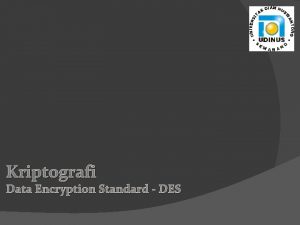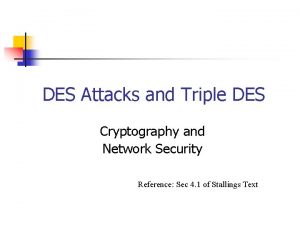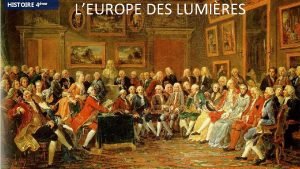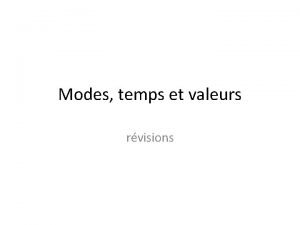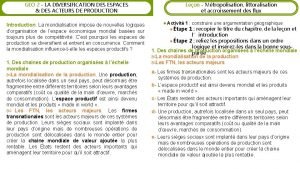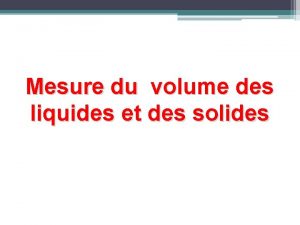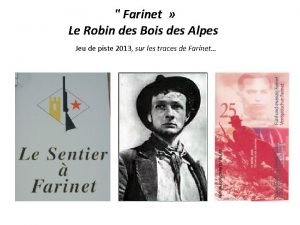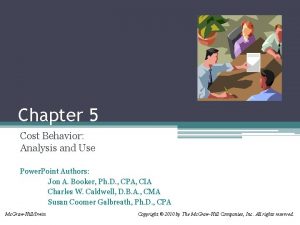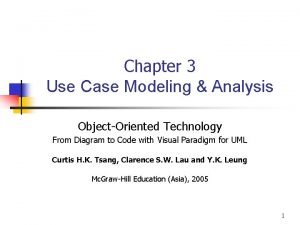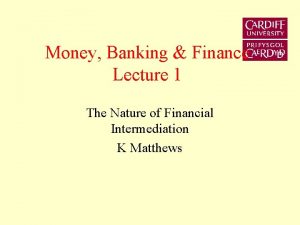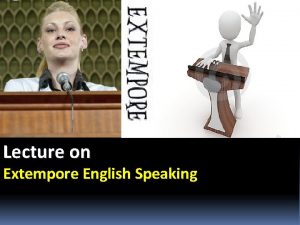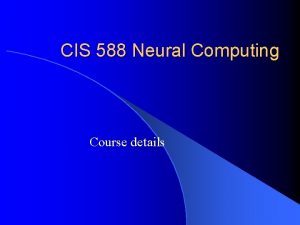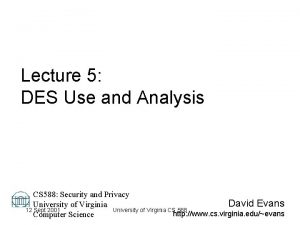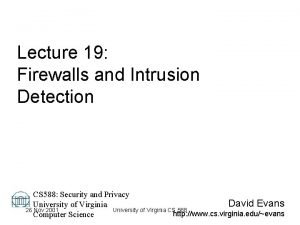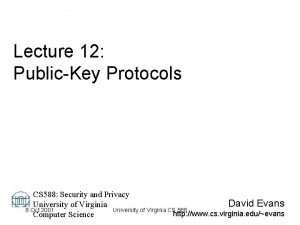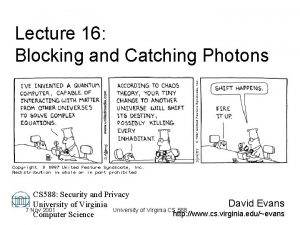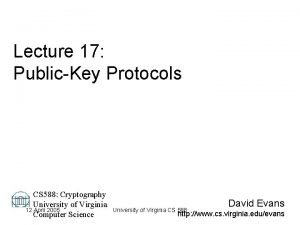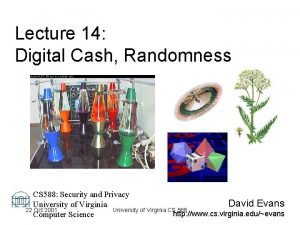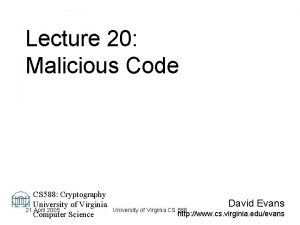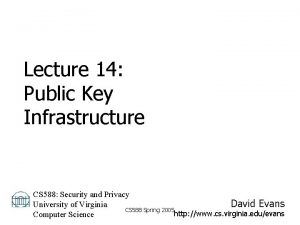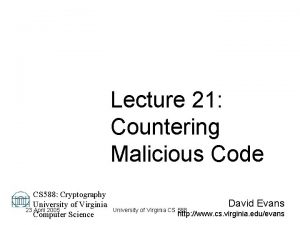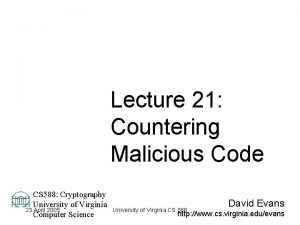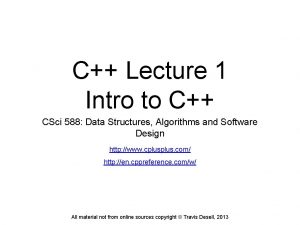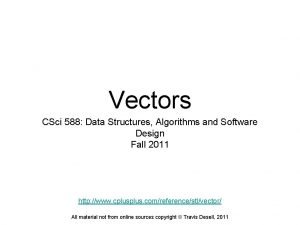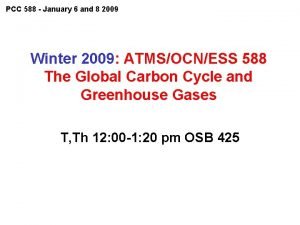Lecture 5 DES Use and Analysis CS 588
























![Differential Cryptanalysis • [Biham & Shamir, 1990] • Choose plaintext pairs with fixed difference: Differential Cryptanalysis • [Biham & Shamir, 1990] • Choose plaintext pairs with fixed difference:](https://slidetodoc.com/presentation_image_h/071d28de7baed73f4479233c53a0aa96/image-25.jpg)















- Slides: 40

Lecture 5: DES Use and Analysis CS 588: Security and Privacy David Evans University of Virginia 12 Sept 2001 University of Virginia CS 588 http: //www. cs. virginia. edu/~evans Computer Science

Menu • • • Today’s manifest: on line only DES Review Modes of Operation 3 DES Attacks • Return PS 1 12 Sept 2001 University of Virginia CS 588 2

DES Structure Plaintext Initial Permutation L 0 = left half of plaintext R 0 = right half of plaintext R 0 Substitution K 1 F Permutation 16 x Round L 0 Li = Ri - 1 R i = L i - 1 F ( R i - 1, K i ) C = Rn || Ln L 1 12 Sept 2001 R 1 n is number of rounds (undo last permutation) University of Virginia CS 588 3

DES’s F 32 bits Expand Permute (using E table) 48 bits Kn Substitute (using S boxes) 32 bits Permutation 12 Sept 2001 University of Virginia CS 588 4

Expansion/Permutation 01101… 1 32 bits 32 1 2 3 4 5 6 7 8 9 12 13 14 15 16 17 18 19 20 21 24 25 26 27 28 29 8 9 10 11 12 13 20 21 22 23 24 25 28 29 30 31 32 1 48 bits 10110101… 0 12 Sept 2001 University of Virginia CS 588 5

S-Boxes 48 bits 000011… 00000011 … 1110 0100 1111 … 111111 1101 7 more different S-boxes for bits 7 -48 5 -32 32 bits 1111… Nothing secret about the S-Boxes (but they are confusing) 12 Sept 2001 University of Virginia CS 588 6

Modes of Operation 12 Sept 2001 University of Virginia CS 588 7

Modes of Operation • Transmitting a long plaintext using DES: P = P 1 || P 2 ||. . . || PN • Electronic Codebook Mode: C = EK (P 1) || EK (P 2) ||. . . || EK (PN) • Problems: – Any identical blocks encrypted identically • 64 bits = 8 ASCII characters – Lots of ciphertext encrypted with same K 12 Sept 2001 University of Virginia CS 588 8

Cipher Block Chaining P 1 P 2 IV K DES C 1 to receiver 12 Sept 2001 K DES . . . C 2 to receiver University of Virginia CS 588 9

Cipher Block Chaining Ci = EK (Pi Ci - 1) C 1 = EK (P 1 IV) Decrypt: Mi = DK (Ci ) Ci - 1 M 1 = DK (C 1 ) IV DK (EK (Pi Ci - 1)) Ci – 1 = Pi Ci - 1 Ci – 1 = Pi 12 Sept 2001 University of Virginia CS 588 10

Cipher Feedback Mode shift j bits IV K K DES j bits P 1 12 Sept 2001 j bits C 1 to receiver . . . DES P 2 C 2 to receiver University of Virginia CS 588 11

Output Feedback Mode shift j bits IV K K DES j bits P 1 12 Sept 2001 j bits C 1 to receiver . . . DES P 2 C 2 to receiver University of Virginia CS 588 12

Cipher/Output Feedback • 1 -bit transmission error • Active eavesdropper • Performance 12 Sept 2001 University of Virginia CS 588 13

Multiple Encryption 12 Sept 2001 University of Virginia CS 588 14

Multiple Encryption • C = EK 2 (EK 1 (P)) • Does it double the key space? • Monoalphabetic cipher Ci = K 2[K 1[Pi]] = K 3[Pi] for some K 3 12 Sept 2001 University of Virginia CS 588 15

Double-Vigenère C = EK 2 (EK 1 (P)) Vigenère: Ci = (Pi + Ki mod N) mod Z Ci = ((Pi + K 1 i mod N 1 mod Z) + K 2 i mod N 2) mod Z = (Pi + K 1 i mod N 1 + K 2 i mod N 2 ) mod Z if N 1 = N 2: = (Pi + K 3 i mod N) mod Z (K 3 = K 1 + K 2) what if N 1 N 2? 12 Sept 2001 University of Virginia CS 588 16

Double-Vigenère • K 1 = "BOND" • K 2 = "JAMES" BONDBONDBONDBOND + JAMESJAMESJAMESJAM = KOZHTXNPFGWDNSFMBARVKOZHTXNP • Effective key length: LCM (N 1, N 2) = 20 12 Sept 2001 University of Virginia CS 588 17

Double DES • C = EK 2 (EK 1 (P)) • Is there a K 3 such that C = EK 3 (P)? – There are 256 keys, and 264! mappings – If DES is good, keys map randomly to mappings. – Probability that a randomly chosen mapping corresponds to a DES key: 256 / 264! << 1 / 263! • Effective key size of Double DES? = 256 * 256 = 2112 WRONG! 12 Sept 2001 University of Virginia CS 588 18

Known Plaintext Attack P K 1 K 2 E E try all possible keys P E C XK 1 XK 2 YK 1 YK 2 XK 256 YK 256 D C One XKi = YKj means K 1 = Ki and K 2 = Kj 12 Sept 2001 University of Virginia CS 588 19

Meet-in-the-Middle Attack • C = EK 2 (EK 1 (P)) • X = EK 1 (P) = DK 2 (C) • Brute force attack (given one P/C pair): calculate EK 1 (P) for all keys (256 work) calculate DK 2 (C) for all keys (256 work) the match gives the keys • Total work = 2 * 256 = 257 12 Sept 2001 University of Virginia CS 588 20

2 -Key Triple DES • C = EK 1 (DK 2 (EK 1 (P))) • Why DK 2 not EK 2? – Backwards compatibility with DES – If K 1 = K 2: C = EK 1 (DK 1 (EK 1 (P))) = EK 1 (P) • Actual key size = 56 + 56 bits = 112 bits • Meet-in-the-middle? – X = EK 1 (P) = DK 1 (EK 2 (C)) 256 need to try 2112 12 Sept 2001 University of Virginia CS 588 21

How secure is Triple-DES • Brute force search: 2112 keys – Best DES attack: 245 B keys/second – 6. 7 * 1014 years (compared to 22 hours) – 1011 years = total lifetime of universe (closed universe theory) • Best known attack - reduces to 2120 -log 2 n – n = number of known P-C pairs – n = 264, work is 256 Realistic? 12 Sept 2001 University of Virginia CS 588 22

3 -Key Triple DES • • C = EK 3 (DK 2 (EK 1 (P))) H(K) = 168 Used by PGP, S/MIME How much work to brute-force? – Meet-in-the-middle: X = DK 3 (C) = DK 2 (EK 1 (P)) 256 12 Sept 2001 + 2112 University of Virginia CS 588 23

DES Attacks • Last time: brute force – Best result: 22 hours – But no where near good enough for 3 DES • Differential Cryptanalysis • Power Cryptanalysis 12 Sept 2001 University of Virginia CS 588 24
![Differential Cryptanalysis Biham Shamir 1990 Choose plaintext pairs with fixed difference Differential Cryptanalysis • [Biham & Shamir, 1990] • Choose plaintext pairs with fixed difference:](https://slidetodoc.com/presentation_image_h/071d28de7baed73f4479233c53a0aa96/image-25.jpg)
Differential Cryptanalysis • [Biham & Shamir, 1990] • Choose plaintext pairs with fixed difference: X = X X’ • Use differences in resulting ciphertext to guess key probabilities • With enough work (247) and enough chosen plaintexts (247) can find key (compared to 256 brute force work) Takes 3 years of 1. 5 Mbps encrypting chosen plaintext! 12 Sept 2001 University of Virginia CS 588 25

One Round X X’ 32 bits E/P X 1 48 bits Kn X 2 32 bits E/P X 1’ 48 bits X 2’ S S X 3 32 bits X 3’ P X 4 12 Sept 2001 E/P preserves values: Xi = 0 X 1 ep(i) = X 1 ep(i)’ where ep(i) is a function defined by 32 bits the E table P X 4’ X = X X’ Xi = 0 iff Xi = Xi’ preserves values: X 2 i = X 1 i Kn X 2 i’ = X 1 i’ Kn Xi = 0 X 2 ep(i) = X 2 ep(i)’ University of Virginia CS 588 26

One Round, cont. X 2’ X 2 S S Xi = 0 X 2 ep(i) = X 2 ep(i)’ X 3 P X 4 P X 3 i = X 3 i’ X 4 p(i) = X 4 p(i)’ X 4’ S-boxes are non-linear! (Known from ciphertext) Xi = 0 X 3 s(ep(i)) = X 3 s(ep(i))’ But, maybe they do probabilistically: Xi = 0 p(X 3 s(ep(i)) = X 3 s(ep(i))’) >. 5 ? p(X 3 s(ep(i)) = X 3 s(ep(i))’) <. 5 ? Its a function of the key: p determined experimentally. 12 Sept 2001 University of Virginia CS 588 27

S-box: S 1 6 bits: x 1 x 2 x 3 x 4 x 5 x 6 x 2 x 3 x 4 x 5 select column x 1 x 6 0 1 2 3 4 5 6 7 8 9 A B C D E F 00 E 4 D 1 2 F B 8 3 A 6 C 5 9 0 7 01 0 F 7 4 E 2 D 1 A 6 C B 9 5 3 8 10 4 1 E 8 D 6 2 B F C 9 7 3 A 5 0 F C 8 2 4 9 1 7 5 B 3 E A 0 6 D 11 4 inputs to S 1 produce 0: 011100, 000001, 111110, 111011 12 Sept 2001 University of Virginia CS 588 28

Partial pair XOR Distribution, S 1 Input XOR Output XOR 0 1 2 3 4 5 6 7 8 9 A B C D E F 0 64 0 0 0 0 1 0 0 6 2 4 4 0 10 12 4 10 6 2 4 2 0 0 0 8 0 4 4 4 0 6 8 6 12 6 4 2 4 8 4 2 4 0 2 4 4 2 4 8 6 2 2 . . . 3 F 12 Sept 2001 University of Virginia CS 588 8 29

S-box: S 1 00 01 10 11 0 1 2 3 4 5 6 7 8 9 A B C D E F E 0 4 F 1 C D 7 E 8 1 4 8 2 2 E D 4 F 2 6 9 B D 2 1 8 1 B 7 3 A F 5 A 6 C B 6 C 9 3 C B 7 E 5 9 3 A 9 5 A 0 0 3 5 6 7 8 0 D Difference in last input bit difference in output bits 0101 0001 + 0101 = 0100 (1 XOR 5 = 1) 1011 + 0101 = 1110 (B XOR 5 = E) 12 Sept 2001 University of Virginia CS 588 30

Differential Cryptanalysis • Propagate experimental probabilities for 1 round through 16 rounds • After enough P-C pairs, one key becomes most probable • Difficulty depends heavily on S-Box choices • First published in 1990, but NSA knew about it in 1973! 12 Sept 2001 University of Virginia CS 588 31

Differential Cryptanalysis • “Successful” on DES up to 15 rounds (better than exhaustive search) • By 16 th round, characteristics probabilities are 2 -56 • Very successful on DES variants (breaks GDES with 6 chosen plaintexts) • Very successful on FEAL (FEAL-4, FEAL-8, FEAL-NX, . . . ) 12 Sept 2001 University of Virginia CS 588 32

Current (m. A) 3. 75 3. 50 3. 25 1 2 3 4 5 6 7 8 9 10 11 0 12 13 14 15 16 8. 0 Time (m. S) 12 Sept 2001 University of Virginia CS 588 33

DES Power Consumption 16 DES Rounds 1 2 3 4 5 6 7 8 9 10 11 Detail: Round 2 12 13 14 15 16 Round 3 From http: //www. cryptography. com/dpa/technical/index. html Microprocessors use different amount of power depending on what they are doing! 12 Sept 2001 University of Virginia CS 588 34

Power Analysis Scenario • Attacker has physical device that encrypts and decrypts using a secret key • Is this realistic? Smart Cards (Mondex) 12 Sept 2001 University of Virginia CS 588 35

Side Channel Cryptanalysis • Regular Cryptanalysis: mathematical – Attacker sees inputs, outputs • Side Channel Cryptanalysis – Attacker sees something else: power consumption, encryption/decryption time, radiation, etc. • Depends on implementation of algorithm 12 Sept 2001 University of Virginia CS 588 36

Measuring Power Consumption • Add a resistor between power source and device, measure voltage across resistor I = V/R • Can sample at over 1 GHz with < 1% error 12 Sept 2001 University of Virginia CS 588 37

Power Use Reveals Key • Current for a left shift depends on leftmost bit: – if 1, need to set rightmost bit after • DES key schedule uses shifts, can tell bits in key! • Current for XOR may depend on number of switches 12 Sept 2001 University of Virginia CS 588 38

Defenses • Reduce signal – Physical shielding, microprocessor design (make all shifts use same power, etc. ) • Introduce random noise – Change execution order, do random computation, etc. • Design cryptosystems with DPA in mind – Nonlinear key updates between transactions 12 Sept 2001 University of Virginia CS 588 39

Charge • Continue thinking about project ideas – Each project group should send me email or talk to me by next week about what you are considering • Next time: modern block ciphers – Read AES papers before next class 12 Sept 2001 University of Virginia CS 588 40
 ;bhyjd
;bhyjd 02 588
02 588 02 588
02 588 02 588
02 588 Des des des
Des des des 01:640:244 lecture notes - lecture 15: plat, idah, farad
01:640:244 lecture notes - lecture 15: plat, idah, farad Triple des meet in the middle attack
Triple des meet in the middle attack Land use planning lecture notes
Land use planning lecture notes Land use planning '' lecture notes
Land use planning '' lecture notes Land use planning lecture notes
Land use planning lecture notes Le la les un une des in french
Le la les un une des in french La diffusion des idées des lumières
La diffusion des idées des lumières Il existe des personnes qui sont des lumières pour tous
Il existe des personnes qui sont des lumières pour tous Présent de narration
Présent de narration Affiche propagande guerre froide
Affiche propagande guerre froide Diversification des espaces et des acteurs de la production
Diversification des espaces et des acteurs de la production Le volume d'un corps
Le volume d'un corps Volume des liquides et des solides
Volume des liquides et des solides Cartographie des flux de valeur
Cartographie des flux de valeur Je t'offrirai des fleurs et des nappes en couleurs
Je t'offrirai des fleurs et des nappes en couleurs Robin des bois des alpes
Robin des bois des alpes Budget des ventes
Budget des ventes Exploratory data analysis lecture notes
Exploratory data analysis lecture notes Sensitivity analysis lecture notes
Sensitivity analysis lecture notes Factor analysis lecture notes
Factor analysis lecture notes Analysis of algorithms lecture notes
Analysis of algorithms lecture notes Quadrant streak
Quadrant streak Zline 667-36
Zline 667-36 Yesterday
Yesterday Cost behavior analysis
Cost behavior analysis Use case id
Use case id Musee des beaux arts analysis
Musee des beaux arts analysis Electricity and magnetism lecture notes
Electricity and magnetism lecture notes Power system dynamics and stability lecture notes
Power system dynamics and stability lecture notes Microbial physiology and metabolism lecture notes
Microbial physiology and metabolism lecture notes Limits fits and tolerances
Limits fits and tolerances Parallel and distributed computing lecture notes
Parallel and distributed computing lecture notes 40h11 tolerance
40h11 tolerance Financial intermediaries ppt
Financial intermediaries ppt Banking and finance lecture
Banking and finance lecture Extempore and lecture
Extempore and lecture




